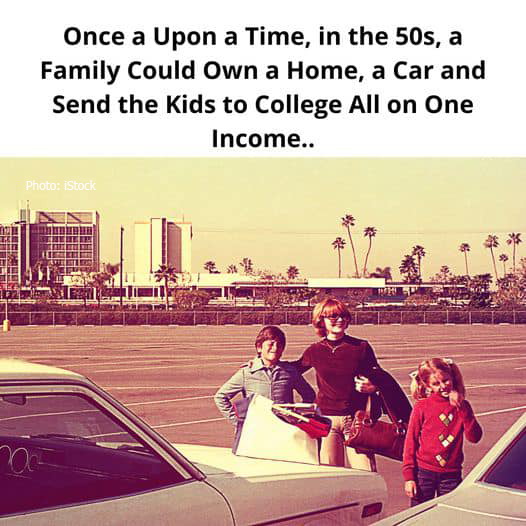The Golden Era of the American Dream
In America, the 1950s is often romanticized as a time when the American Dream was within reach for many families. This era saw unprecedented economic growth and prosperity, allowing a single income to provide for a household’s needs and aspirations.
A typical family in the 1950s could afford a car, a home, and even the cost of a college education for their children, all on one breadwinner’s salary. Today, this scenario seems almost mythical. To understand how we got here, we need to look at the economic and social factors that have changed over the decades.
Economic Prosperity and Stability
The boom after World War II ended fueled an era of economic prosperity in the United States. The GI Bill helped returning veterans purchase homes and pursue higher education, injecting money into the economy and creating a burgeoning middle class. Manufacturing jobs were plentiful and paid well, often with benefits that today’s workers can only dream of. These jobs provided a stable income that could support an entire family comfortably.
Additionally, the housing market was vastly different. The federal government heavily subsidized home loans, making it easier for families to purchase homes. Suburban development flourished, and with it came the ideal of homeownership as the cornerstone of the American Dream. Additionally, the cost of living was lower, and the dollar had much more purchasing power than it does today.
Social and Cultural Norms
Societal norms in the 1950s were such that the majority of households were single-income, typically with men as the breadwinners and women as homemakers. This dynamic was supported by a social structure that valued stable, long-term employment and job security. Pensions and comprehensive benefits were common, ensuring that workers and their families were protected financially.
The Decline of Single-Income Households
Comparing to the present, the landscape has changed dramatically. Several key factors have contributed to the decline of the single-income household:
Stagnant Wages and Rising Costs: wages for the average worker have stagnated, but the cost of living has skyrocketed. Housing, healthcare, and education costs have all increased significantly, outpacing wage growth. This discrepancy makes it difficult for a single income to cover all household expenses.
Shift in Employment: The manufacturing sector, which provided many of the stable, well-paying jobs in the 1950s, has diminished. Many of these jobs have been outsourced or replaced by automation. The service sector, which has grown in its place, often offers lower wages and fewer benefits.
Dual-Income Necessity: due to the rising cost of living, it has become increasingly necessary for households to have dual incomes to maintain a middle-class lifestyle. This shift has also been influenced by changing societal norms, with more women pursuing careers and higher education.
Higher Education Costs: The cost of college education has soared, far exceeding inflation. This has made it difficult for families to afford tuition without taking on significant debt, a stark contrast to the 1950s when college was more affordable and often achievable on a single income.
The Future of the American Dream
To reclaim the possibility of achieving the American Dream on a single income, it is necessary to have substantial changes. Policies that address wage stagnation, make higher education affordable, and provide affordable housing are crucial. Additionally, reviving the manufacturing sector and ensuring job security can help create a stable economic environment.
In addition, a shift in corporate practices to prioritize employee well-being over shareholder profits can contribute to a more equitable distribution of wealth. Investing in infrastructure and education, and promoting fair trade practices can also help rebuild a robust middle class.
Conclusion
The nostalgia for the 1950s shows a longing for economic stability and opportunity that seems out of reach for many today. By understanding the factors that have changed since then, we can work towards creating a society where the American Dream is once again attainable for all, even on a single income.


















